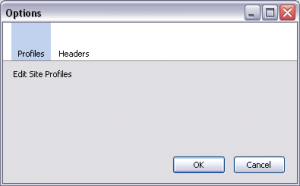The combination of <prefwindow> and <prefpane>‘s provides Firefox addon developers with an effective mechanism for creating a preferences dialog. The best example of <prefwindow> usage is the Firefox options dialog.
This tech note will focus on getting all the elements of the <prefwindow> framework right as it is fairly easy to miss one small element, leaving you scratching your head. Below is a screenshot of the end result.
Setting up the <prefwindow>
The code below a minimal <prefwindow> page with two <prefpane>‘s. If only one <prefpane> is used, the navigation bar is not displayed. When two or more <prefpane>‘s are used, a navigation bar is added at the top of the page.
<?xml version="1.0"?>
<?xml-stylesheet href="chrome://global/skin/global.css"?>
<prefwindow id="modifyheadersPreferences"
xmlns="http://www.mozilla.org/keymaster/gatekeeper/there.is.only.xul"
style="width: 42em; min-height: 37.5em;">
<prefpane id="paneProfiles" label="Profiles"
src="chrome://modifyheaders/content/profiles.xul"/>
<prefpane id="paneHeaders" label="Headers"
src="chrome://modifyheaders/content/headers.xul"/>
</prefwindow>
For this example, the contents of each <prefpane> are contained in external files, but you can place content directly between <prefpane> start and end tags. No content should appear above between the opening <prefwindow> element and the <prefpane> elements. If any scripts or other content must be defined, place them after the last <prefpane>.
Defining <prefpane> panels
There are several rules for defining <prefpane>s in external files:
- The root tag must be an
<overlay>. - The id of the
<prefpane>must match the id specified in the<prefwindow> - A
<preferences>element must be specified, even if it is empty
Here is an example for the <prefpane> with id="paneProfiles".
<?xml version="1.0"?>
<overlay id="modifyheaders-profiles-overlay"
xmlns="http://www.mozilla.org/keymaster/gatekeeper/there.is.only.xul">
<prefpane id="paneProfiles" label="Profiles">
<preferences/>
<vbox id="modifyheaders-profiles">
<description>Edit Site Profiles</description>
</vbox>
</prefpane>
</overlay>
This markup is repeated for each <prefpane> you need to define. Only the id attribute must be unique.
Opening the <prefwindow> using javascript
This is the bit that caught me out. You have to be careful about which features are specified for the window. Typically for a XUL dialog, you would use:
window.openDialog("chrome://modifyheaders/content/dialog.xul", "modifyheadersDialog", "resizable,dialog,centerscreen,modal", this);
The third argument lists the features for the dialog. In this case: resizable, dialog, centerscreen, modal. For a <prefwindow>, you have to make sure the toolbar feature is specified. Resizeable can be ignored as it seems to have no affect on this type of window:
window.openDialog("chrome://modifyheaders/content/preferences.xul", "modifyheadersPreferences", "chrome,titlebar,toolbar,centerscreen,modal", this);
That about wraps it up. As you can see, it is straightforward enough. For further information, here are some further references from MDC:


Thanks for the good writeup. As good a the Mozilla docs are, they never seem to post complete, working examples.